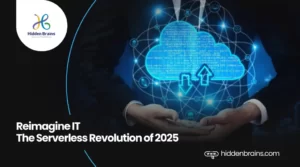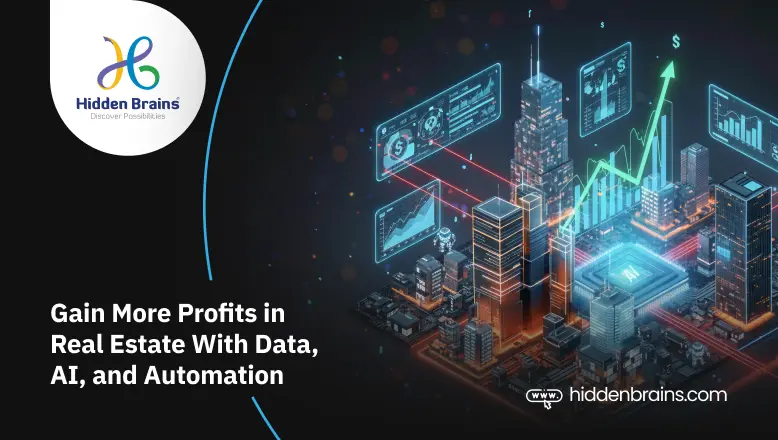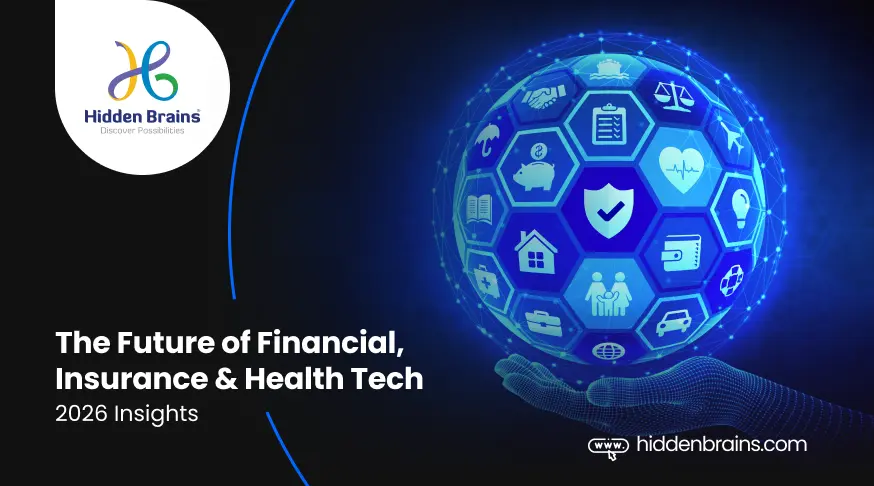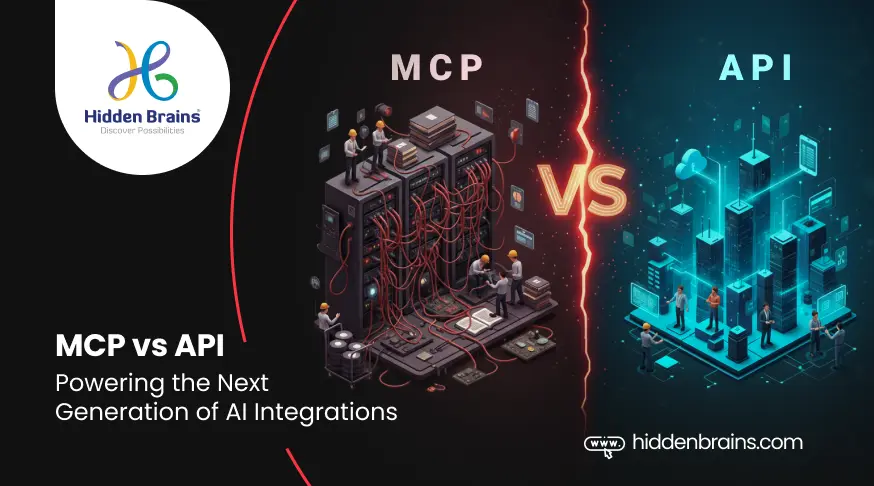Overview
The Hidden Brains blog on Serverless Architecture explores the transformative impact of serverless computing on IT strategies by 2025. It delves into the mechanics of serverless systems, highlighting their benefits such as cost efficiency, scalability, and reduced infrastructure management. The article also examines how serverless architecture addresses existing challenges in application development and deployment. Looking ahead, it identifies major shifts in serverless technologies and provides insights into the top service providers. Additionally, the blog offers guidance on preparing IT strategies for a serverless future and underscores why businesses should consider Hidden Brains for serverless development solutions.
The innovation of serverless architecture, a revolutionary cloud computing model, has entirely changed how software applications are designed and built. Serverless application architecture allows developers to create and manage applications without worrying about physical infrastructure management.
In 2025, serverless computing is all set to revolutionize the software development workflow by automating essential server management tasks.
According to KBV Research, the serverless computing market is expected to reach $56.41 billion by 2031, enhancing multi-cloud support while incorporating cutting-edge cost prediction tools. In 2025, serverless architecture will empower developers to focus entirely on improving the app’s performance and functionalities by improving cold start times and integrating AI properties.
Serverless architecture is ready to become a core element of today’s IT systems because it brings unmatched scalability and cheaper options. Our blog explains how serverless architecture transforms IT systems and shows why using it today secures your business against future developments.
What Is Serverless Architecture?
People often confuse the term ‘serverless’ by thinking no servers are involved in developing an application. However, it does not mean a lack of servers- developers are not required to manage or maintain servers while designing and developing. In serverless architecture, cloud service providers manage an app development’s physical assets, maintenance, upgrades, and scalability. It allows developers to build apps and improve their functionalities.
How Does Serverless Architecture Work?
With serverless architecture, code executes on event-based triggers through an event-driven computing model when users make HTTP requests, upload files, or update database data.
Automatic Scaling
Our system adjusts resource allocation automatically to match changing workloads so users get top output without human assistance.
Pay-as-you-go Pricing
Businesses pay only for the active time their code requires, which is milliseconds, without needing to pay for unused resources. Since they scale automatically and take time measured in milliseconds, serverless works best with applications and workloads that require quick setup and adaptation.
What Are the Benefits of Serverless Architecture?
Modern web and mobile applications’ efficiency and performance depend on serverless architecture. It offers a wide range of benefits for both developers and businesses.
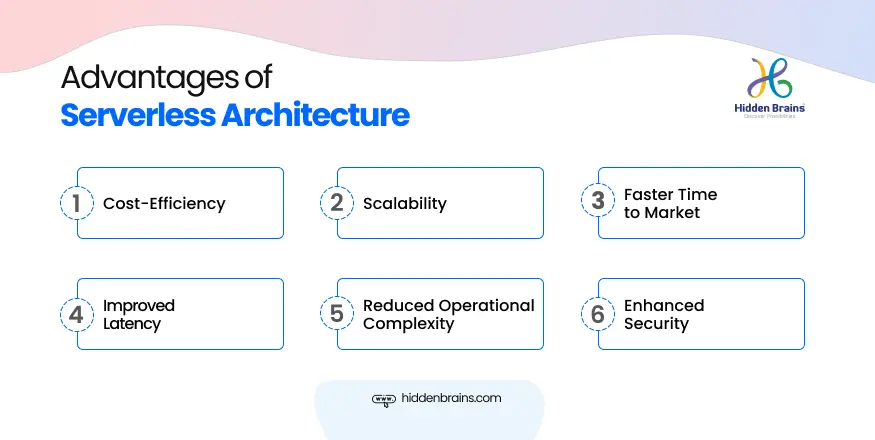
The benefits of serverless architecture help enterprises streamline their present operations and position themselves for future scaling and innovations. Let’s check out the benefits.
Cost-efficiency
The main benefit of serverless architecture comes from its ability to save costs. In contrast to regular setups, companies only pay for actual service time without having to purchase servers upfront. Your payment covers only the minutes your app code occupies and the resources it uses. A serverless setup saves businesses money by stopping payments when servers are idle and for unused resources.
Scalability
Serverless architecture provides automatic scaling, adapting seamlessly to fluctuations in demand. Your serverless architecture adjusts how much work your resources handle based on demand volume at all traffic levels. Your application’s changing traffic needs can run automatically without human help or unnecessary resource purchases. Eventually, it allows you to expand your operations and reach.
Faster Time-to-market
By removing the need to manage infrastructure, the serverless architecture enables developers to focus entirely on building and deploying core functionalities. Teams can write code, deploy it, and see it run almost instantly, cutting down development cycles. This agility is especially valuable for startups and businesses looking to launch products quickly and stay competitive in fast-paced markets.
Improved Latency
Serverless functions use selected access points worldwide, letting users run their system from wherever they are. The distributed network setup reduces distance to users for faster results and improves customer service on a global scale.
Reduced Operational Complexity
Businesses eliminate server management work through serverless computing because the cloud provider handles all system updates without their intervention. Cloud providers manage these tasks so IT teams can concentrate on creating new systems instead of essential administration work. The simple system makes work easier and decreases the possibility of worker mistakes.
Enhanced Security
Serverless platforms come with built-in security measures and are constantly updated by cloud providers to address vulnerabilities and threats. By abstracting infrastructure management, serverless minimizes potential attack vectors. Additionally, providers handle patch management, encryption, and access control tasks, giving businesses a robust foundation to build secure applications.
How Will Serverless Impact IT Strategy in 2025?
As the serverless architecture market is nearing $15.86 billion, it is emerging as a key enabler of innovation. By 2025, serverless computing is expected to address existing pain points, introduce game-changing solutions, and align seamlessly with emerging IT trends.

Let’s explore how this evolution is set to redefine IT strategies and resolve long-standing challenges.
Enhanced Developer Tooling
Serverless development and debugging used to be hard because developers lacked proper tools and followed complex processes. By 2025, expect a leap forward with:
Advanced Debugging Capabilities
Serverless technology companies now offer better tools that help users quickly troubleshoot their function problems.
Modern Monitoring Systems
AI tools help monitor application performance live so developers can fix problems more efficiently.
Streamlined Deployment Workflows
Bare-metal developers can work more quickly because they get total work support that helps them better deploy and update serverless programs.
Cost Optimization and Predictability
While serverless is cost-effective, unpredictable costs for high-traffic applications remain a challenge. By 2025, serverless infrastructure will offer:
Granular Pricing Models
Precise billing based on resource usage down to milliseconds, helping businesses manage costs effectively.
Tiered Pricing Options
Providers are introducing plans tailored to specific needs, from startups to enterprises.
Hybrid Deployment Options
A blend of serverless and traditional hosting will allow organizations to optimize costs by balancing workloads between models.
Multi-cloud Support and Vendor Independence
Businesses fear they will become too dependent on serverless architecture service providers when using this technology. The future of serverless will focus on freedom and flexibility with:
Standardized Interfaces Across Providers
Current developments create software frameworks that work equally well with multiple cloud providers, including AWS, Azure, and Google Cloud.
Improved Portability
The upcoming technology will simplify moving serverless workloads between cloud service providers.
Platform-agnostic Development Frameworks
Businesses will gain more freedom to create serverless applications because of these platform-neutral development tools.
Integration with Edge Computing and AI
Serverless is set to play a pivotal role in two of the most transformative technologies: Edge Computing systems use Artificial Intelligence technology.
Event-driven Architectures
Serverless solutions help process IoT information directly to produce immediate action decisions.
AI Integration
Businesses will get better access to AI systems through faster serverless backend deployments. The system gives better results with faster processing and analysis for large datasets.
Proximity to Users
Serverless technology working with edge computing enables faster processing near users, delivering superior results for streaming and gaming applications.
How Does Serverless Solve Existing Challenges?
Serverless architecture database promises a new era in which modern applications and software solutions are created. By leveraging the latest innovations in this field, businesses can build robust and user-friendly tech solutions and address existing pain points.
Inadequate Tooling for Effective Development and Debugging
Emerging developer tools with built-in debugging, monitoring, and error tracing make serverless environments more manageable to navigate and maintain.
Cost Unpredictability
New pricing models and hybrid deployment options give businesses greater control and predictability over serverless costs.
Cold Start Latency Issues
Providers invest in solutions to minimize cold start times, such as pre-warmed instances and intelligent caching mechanisms.
Complex Troubleshooting Processes
AI-driven monitoring and log analysis tools will simplify the identification and resolution of issues, ensuring smoother application performance.
Vendor Lock-in Concerns
Multi-cloud support and standardized serverless interfaces will allow businesses to switch providers without significant overhauls.
What Major Shifts in Serverless to Watch by 2025?
From automated scaling to improved cold start times to cost prediction tools and AI and edge computing integration, serverless application architecture offers much in 2025. Within a short period, it became a go-to choice for developers, focusing more on writing codes than managing servers. The emerging trends you should watch out for in 2025 are as follows:
- Enhanced Developer Tools: Intuitive workflows, AI-powered monitoring, and improved debugging capabilities.
- Cost Optimization: Granular and tiered pricing models for better predictability.
- Multi-cloud Compatibility: Freedom to deploy serverless applications across platforms without rework.
- Edge Computing Integration: Serverless as the backbone of real-time, low-latency applications.
- Event-driven Architectures: Unlocking new possibilities for IoT, AI, and analytics.
Who Are the Top 10 Serverless Providers?
As serverless architecture continues to reshape the IT landscape, major cloud providers and innovative startups are driving this revolution with cutting-edge solutions. The following table will list the top ten cloud service providers that dominate the serverless domain. Check them out.
| Rank | Player | Services Offered | Use Cases | Benefits |
|---|---|---|---|---|
| 1 | Amazon Web Services (AWS) | AWS Lambda, API Gateway, DynamoDB, S3 | Web and mobile backends, data processing, IoT applications, serverless APIs | Scalability, cost-effectiveness, reduced operational overhead |
| 2 | Microsoft Azure | Azure Functions, Logic Apps, Cosmos DB, Blob Storage | Web and mobile backends, integration workflows, data processing, IoT applications | Hybrid cloud integration, enterprise-grade security, developer productivity |
| 3 | Google Cloud Platform (GCP) | Cloud Functions, Cloud Run, Cloud Spanner, Cloud Storage | Web and mobile backends, data processing, machine learning, microservices | Global infrastructure, strong AI/ML integration, innovative serverless offerings |
| 4 | IBM Cloud | Cloud Functions, App Connect, Cloudant, Object Storage | Hybrid cloud integration, enterprise applications, data analytics, IoT | Enterprise focus, hybrid cloud capabilities, strong in hybrid cloud |
| 5 | Oracle Cloud | Functions, API Gateway, Autonomous Database, Object Storage | Enterprise applications, data warehousing, supply chain management, CRM | Strong in database and enterprise applications, growing serverless portfolio |
| 6 | Alibaba Cloud | Function Compute, API Gateway, ApsaraDB, Object Storage | E-commerce, fintech, gaming, media | Strong presence in Asia, competitive pricing, growing ecosystem |
| 7 | Cloudflare Workers | Serverless computing at the edge | Content delivery, web applications, API gateways, microservices | Global edge network, low latency, security features |
| 8 | Netlify | Serverless functions, static site hosting, CI/CD | Web applications, static sites, JAMstack, front-end development | Developer-friendly platform, focus on web development services, strong community |
| 9 | Vercel | Serverless functions, static site hosting, edge computing | Web applications, front-end development, JAMstack, e-commerce | Fast deployments, global edge network, developer experience |
| 10 | Iron.io | Serverless task queues, message queues, data processing | Background tasks, microservices, event-driven architectures | Reliable task processing, scalable infrastructure, easy integration |
How to Prepare IT Strategy for a Serverless Future?
To build brilliant web and mobile applications in 2025 and beyond, you must develop your IT strategy while anticipating a serverless future. Here is how you should prepare your IT strategy for a serverless future.
Evaluate Your Current Workload
Identify workloads where serverless can deliver the most value, such as event-driven tasks or applications with variable traffic.
Start Small
Begin with specific use cases or workflows to test serverless capabilities and gradually expand as you gain confidence.
Upskill Your Team
Invest in training your team to familiarize them with serverless frameworks, tools, and best practices.
Optimize Design
Adopt modular and event-driven application architectures to leverage serverless environments’ benefits fully.
Choose the Right Provider
Consider scalability, pricing, multi-cloud support, and available tools when selecting a serverless platform that aligns with your business needs.
Why Choose Hidden Brains for Serverless Development?
Unlock the true potential of your business with Hidden Brain’s cutting-edge serverless solutions. Whether it’s creating modern, agile applications or optimizing cloud infrastructure for scalability and security, our expert team has you covered.
From tailored scalability strategies to seamless cloud consulting, migration, DevOps integration, and real-time monitoring, we help you choose the perfect cloud services and deployment models to meet your unique needs. With over 22 years of experience in custom software development across industries, we understand the evolving tech landscape and deliver solutions that prepare your business for the future. Let us help you innovate and grow with confidence!
Frequently Asked Questions
If you have more questions about serverless architecture, our comprehensive FAQ section has all the answers you need to understand its impact in 2025 and beyond.
What is the difference between serverless and traditional architecture?
When using serverless architecture, developers don’t need to handle servers because cloud providers manage infrastructure—the approach of traditional infrastructure demands dedicated server control over their life cycle. Serverless helps with deployment and costs less than basic systems requiring manual hardware control.
Is serverless architecture suitable for all businesses?
Serverless architecture works well for today’s technology needs but remains unsuitable for every scenario. It delivers exceptional results for event-based tasks and variable usage scenarios with microservice organizations. Businesses with unique rule-based systems and slow operations must think deeply about serverless, even with their advantages and drawbacks.
What are the best practices for adopting serverless technologies?
1. Start small by testing serverless with specific workflows or non-critical applications.
2. Design applications with modular, event-driven architectures for scalability.
3. Implement robust monitoring and debugging tools to simplify troubleshooting.
4. Ensure cost predictability by optimizing function usage and monitoring execution times.
5. Train your team to understand serverless principles and use cloud provider tools effectively.
What are the potential challenges of serverless architecture?
Cold Start Delays: Some serverless functions experience delays during initial execution.
Cost Management: High-traffic applications can lead to unexpected costs without careful monitoring.
Debugging Complexity: Troubleshooting distributed serverless applications can be more complex than traditional setups.
Vendor Lock-in: Relying heavily on one cloud provider’s ecosystem may reduce flexibility.
Can serverless architecture support data-intensive applications?
Yes, serverless can handle data-intensive workloads through integration with other cloud services like data lakes, storage solutions, and analytics tools. However, optimizing function execution times and managing costs is crucial when dealing with large-scale data processing.
Conclusion
Serverless architecture is more than a trend; it’s a transformative approach redefining how businesses build, deploy, and scale applications. By addressing challenges like cost unpredictability, inadequate tooling, and vendor lock-in while aligning with emerging trends like edge computing, AI, and multi-cloud strategies, serverless computing is setting the stage for the future of IT.
As we approach 2025, businesses that embrace this technology will get serverless architecture benefits like agility, scalability, and cost-efficiency, giving them a competitive edge in an increasingly digital world. The time to evaluate and adapt your IT strategy for a serverless future is now leverage this innovation to stay ahead and drive your organization’s success.






























































































![Sales & Distribution [Oil & Gas] Sales & Distribution [Oil & Gas]](https://www.hiddenbrains.com/blog/wp-content/themes/blankslate/assets/images/sales_and_distribution-icon.74d08193.svg)

![Fluid Terminal Management [Oil & Gas] Fluid Terminal Management [Oil & Gas]](https://www.hiddenbrains.com/blog/wp-content/themes/blankslate/assets/images/fluid_terminal_management-icon.4b3a27a4.svg)































![Sales & Distribution [Oil & Gas] Sales & Distribution [Oil & Gas]](https://www.hiddenbrains.com/blog/wp-content/themes/blankslate/assets/images/sales_and_distribution-icon.74d08193.svg?1.0.0)
![Fluid Terminal Management [Oil & Gas] Fluid Terminal Management [Oil & Gas]](https://www.hiddenbrains.com/blog/wp-content/themes/blankslate/assets/images/fluid_terminal_management-icon.4b3a27a4.svg?1.0.0)





















































































































































































